Abstract
A rat model of orthotopic corneal graft rejection was used to investigate the effect of depletion of subpopulations of immune cells by treatment with monoclonal antibodies. Though CD4+ cells were not eliminated completely by anti-CD4 monoclonal antibodies there was a profound delay in the rejection times of orthotopic corneal allografts. Furthermore a third of the CD4+ depleted animals failed to reject corneal allografts by 100 days post grafting. Despite an almost complete depletion of circulating CD8+ cells, the anti-CD8 antibody treated animals rejected corneal allografts in a similar time course to allografted controls treated with a non-reactive control antibody OX21. These results demonstrate that CD8+ T-cells are not required for rejection of corneal allografts whereas CD4+ T-cells play a critical role in the rejection response. Treatment with anti-CD4 antibodies may have a useful clinical application.
Full text
PDF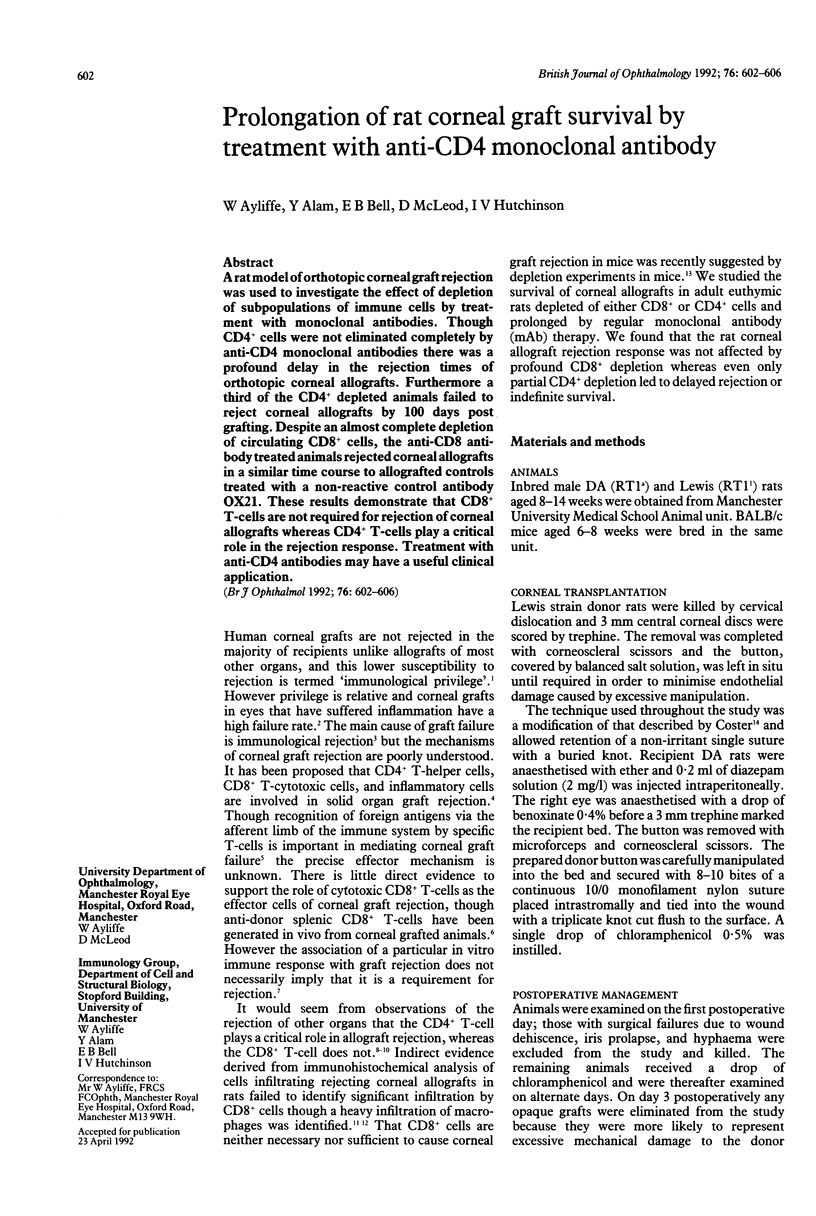
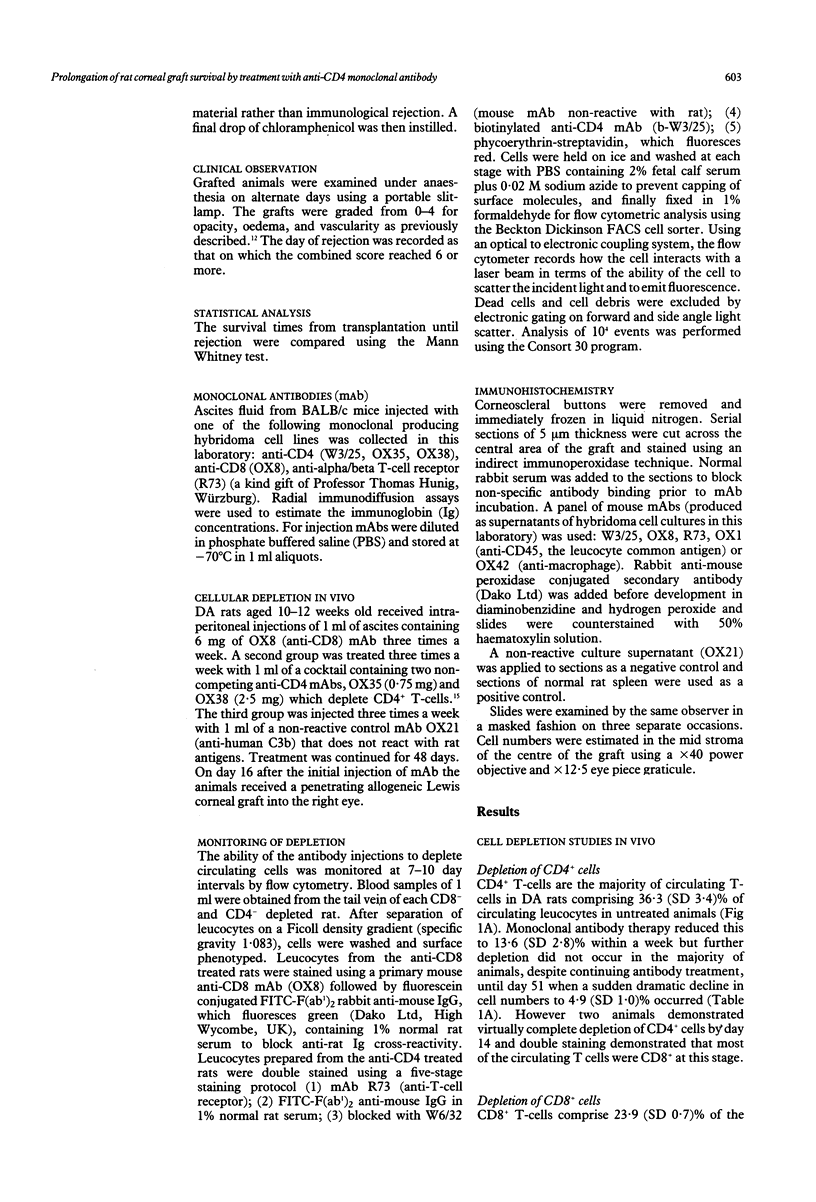
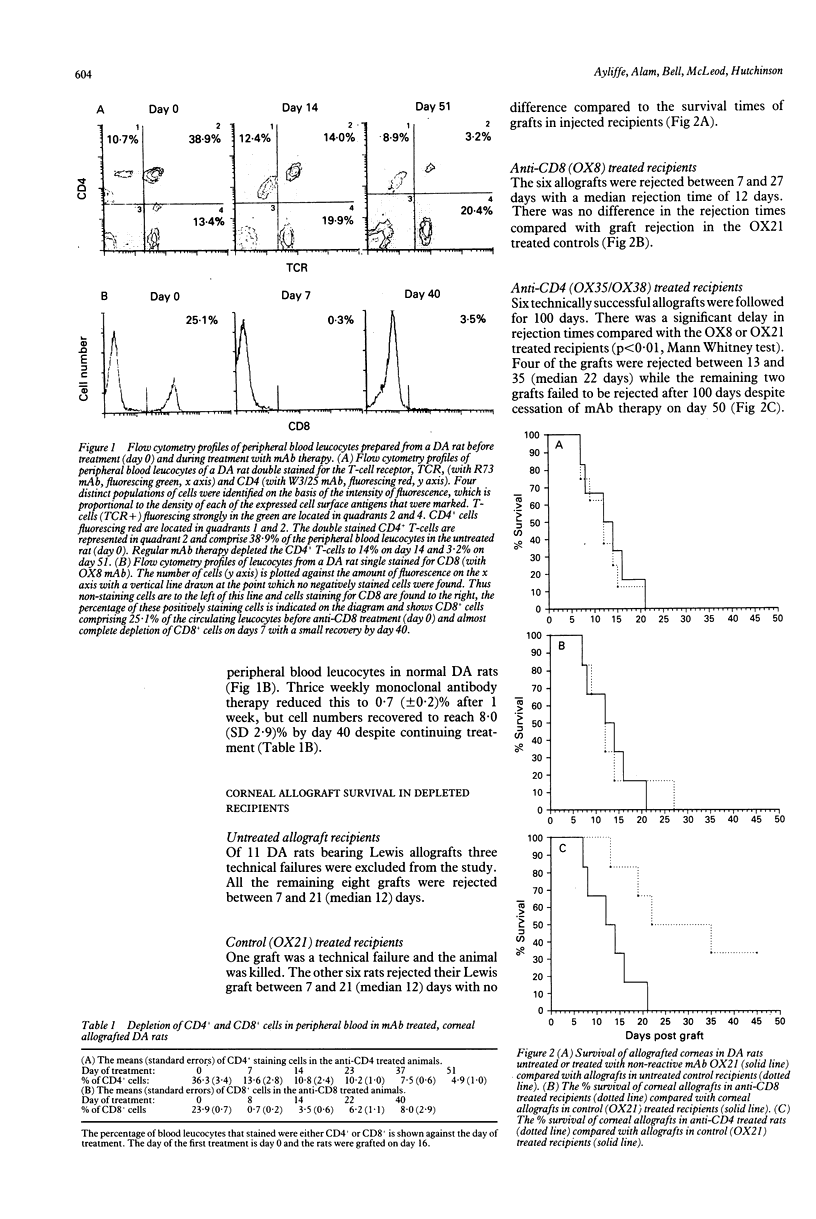
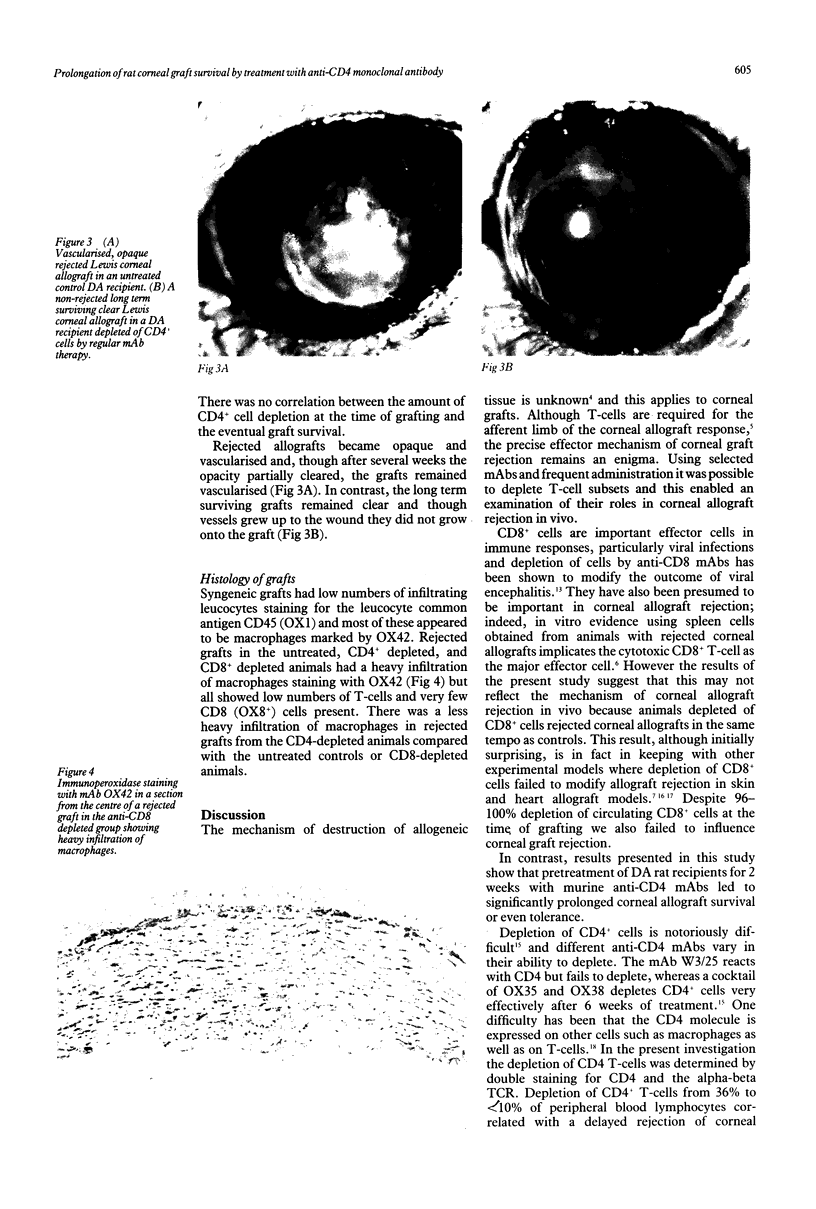
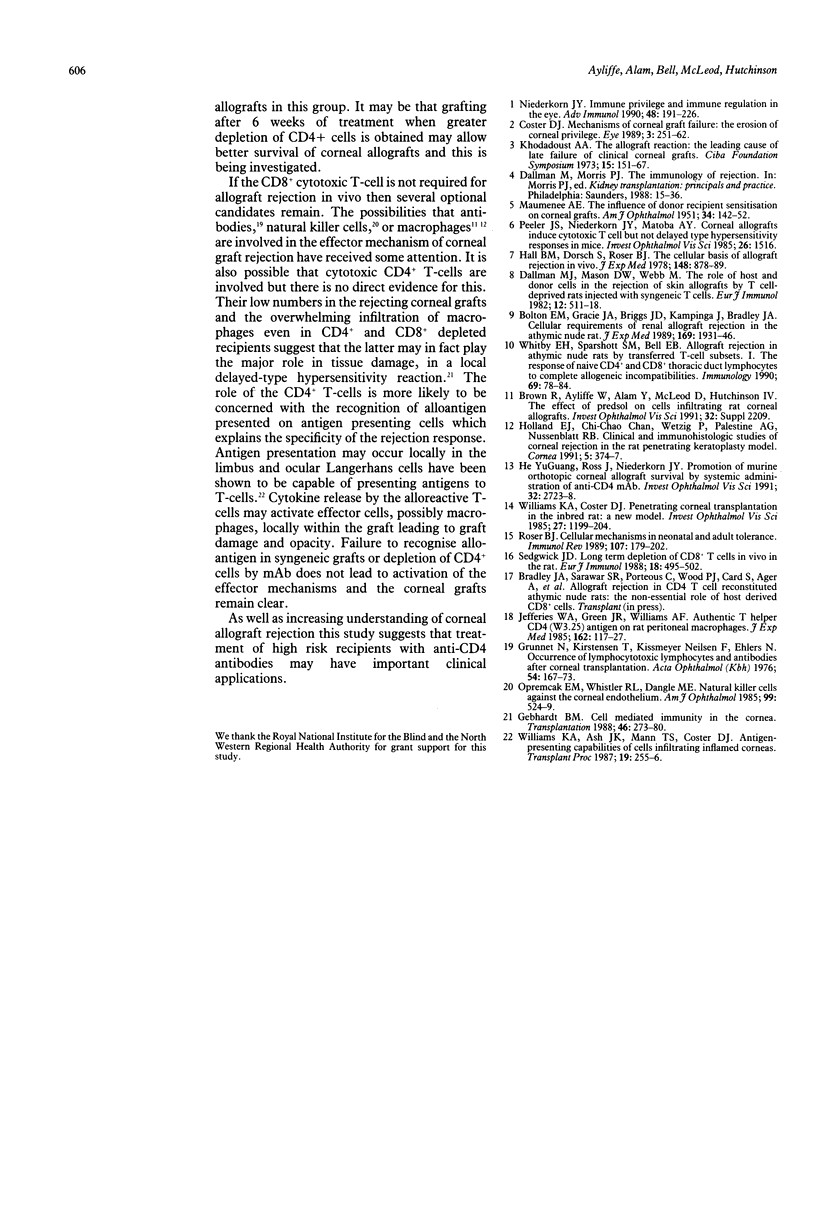
Images in this article
Selected References
These references are in PubMed. This may not be the complete list of references from this article.
- Bolton E. M., Gracie J. A., Briggs J. D., Kampinga J., Bradley J. A. Cellular requirements for renal allograft rejection in the athymic nude rat. J Exp Med. 1989 Jun 1;169(6):1931–1946. doi: 10.1084/jem.169.6.1931. [DOI] [PMC free article] [PubMed] [Google Scholar]
- Coster D. J. Mechanisms of corneal graft failure: the erosion of corneal privilege. Eye (Lond) 1989;3(Pt 3):251–262. doi: 10.1038/eye.1989.35. [DOI] [PubMed] [Google Scholar]
- Dallman M. J., Mason D. W., Webb M. The roles of host and donor cells in the rejection of skin allografts by T cell-deprived rats injected with syngeneic T cells. Eur J Immunol. 1982 Jun;12(6):511–518. doi: 10.1002/eji.1830120612. [DOI] [PubMed] [Google Scholar]
- Gebhardt B. M. Cell-mediated immunity in the cornea. Transplantation. 1988 Aug;46(2):273–280. doi: 10.1097/00007890-198808000-00017. [DOI] [PubMed] [Google Scholar]
- Grunnet N., Kristensen T., Kissmeyer-Nielsen F., Ehlers N. Occurrence of lymphocytotoxic lymphocytes and antibodies after corneal transplantation. Acta Ophthalmol (Copenh) 1976 Apr;54(2 Pt):167–173. doi: 10.1111/j.1755-3768.1976.tb00428.x. [DOI] [PubMed] [Google Scholar]
- Hall B. M., Dorsch S., Roser B. The cellular basis of allograft rejection in vivo. I. The cellular requirements for first-set rejection of heart grafts. J Exp Med. 1978 Oct 1;148(4):878–889. doi: 10.1084/jem.148.4.878. [DOI] [PMC free article] [PubMed] [Google Scholar]
- He Y. G., Ross J., Niederkorn J. Y. Promotion of murine orthotopic corneal allograft survival by systemic administration of anti-CD4 monoclonal antibody. Invest Ophthalmol Vis Sci. 1991 Sep;32(10):2723–2728. [PubMed] [Google Scholar]
- Holland E. J., Chan C. C., Wetzig R. P., Palestine A. G., Nussenblatt R. B. Clinical and immunohistologic studies of corneal rejection in the rat penetrating keratoplasty model. Cornea. 1991 Sep;10(5):374–380. doi: 10.1097/00003226-199109000-00003. [DOI] [PubMed] [Google Scholar]
- Jefferies W. A., Green J. R., Williams A. F. Authentic T helper CD4 (W3/25) antigen on rat peritoneal macrophages. J Exp Med. 1985 Jul 1;162(1):117–127. doi: 10.1084/jem.162.1.117. [DOI] [PMC free article] [PubMed] [Google Scholar]
- MAUMENEE A. E. The influence of donor-recipient sensitization on corneal grafts. Am J Ophthalmol. 1951 May;34(5 2):142–152. doi: 10.1016/0002-9394(51)90019-0. [DOI] [PubMed] [Google Scholar]
- Niederkorn J. Y. Immune privilege and immune regulation in the eye. Adv Immunol. 1990;48:191–226. doi: 10.1016/s0065-2776(08)60755-5. [DOI] [PubMed] [Google Scholar]
- Opremcak E. M., Whisler R. L., Dangel M. E. Natural killer cells against human corneal endothelium. Am J Ophthalmol. 1985 May 15;99(5):524–529. doi: 10.1016/s0002-9394(14)77950-4. [DOI] [PubMed] [Google Scholar]
- Peeler J., Niederkorn J., Matoba A. Corneal allografts induce cytotoxic T cell but not delayed hypersensitivity responses in mice. Invest Ophthalmol Vis Sci. 1985 Nov;26(11):1516–1523. [PubMed] [Google Scholar]
- Roser B. J. Cellular mechanisms in neonatal and adult tolerance. Immunol Rev. 1989 Feb;107:179–202. doi: 10.1111/j.1600-065x.1989.tb00009.x. [DOI] [PubMed] [Google Scholar]
- Sedgwick J. D. Long-term depletion of CD8+ T cells in vivo in the rat: no observed role for CD8+ (cytotoxic/suppressor) cells in the immunoregulation of experimental allergic encephalomyelitis. Eur J Immunol. 1988 Apr;18(4):495–502. doi: 10.1002/eji.1830180402. [DOI] [PubMed] [Google Scholar]
- Tuft S. J., Williams K. A., Coster D. J. Endothelial repair in the rat cornea. Invest Ophthalmol Vis Sci. 1986 Aug;27(8):1199–1204. [PubMed] [Google Scholar]
- Whitby E. H., Sparshott S. M., Bell E. B. Allograft rejection in athymic nude rats by transferred T-cell subsets. I. The response of naive CD4+ and CD8+ thoracic duct lymphocytes to complete allogeneic incompatibilities. Immunology. 1990 Jan;69(1):78–84. [PMC free article] [PubMed] [Google Scholar]
- Williams K. A., Ash J. K., Mann T. S., Coster D. J. Antigen-presenting capabilities of cells infiltrating inflamed corneas. Transplant Proc. 1987 Feb;19(1 Pt 1):255–255. [PubMed] [Google Scholar]




